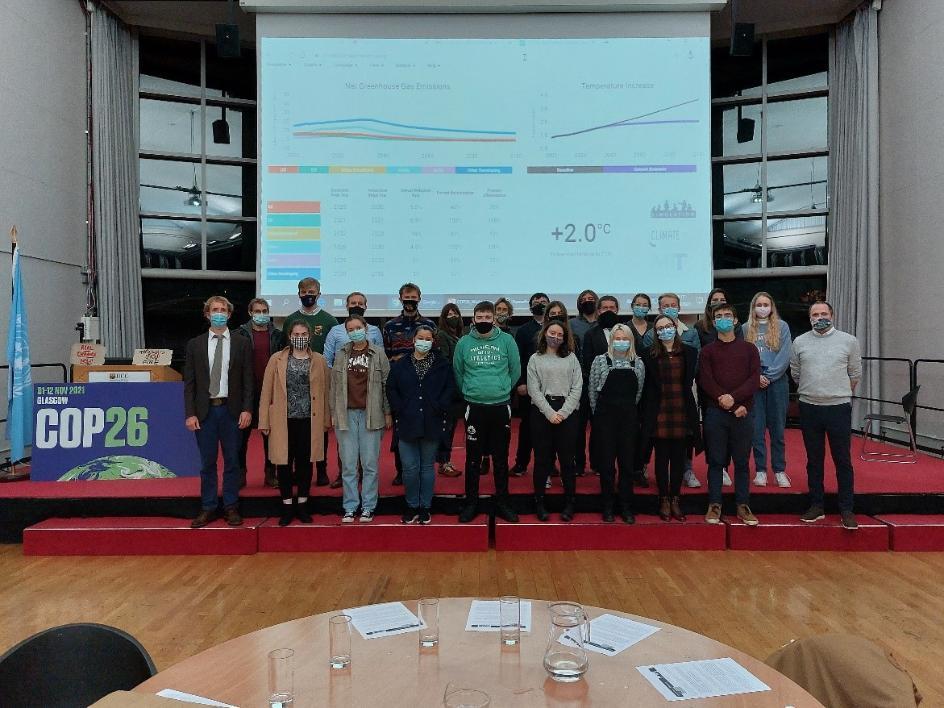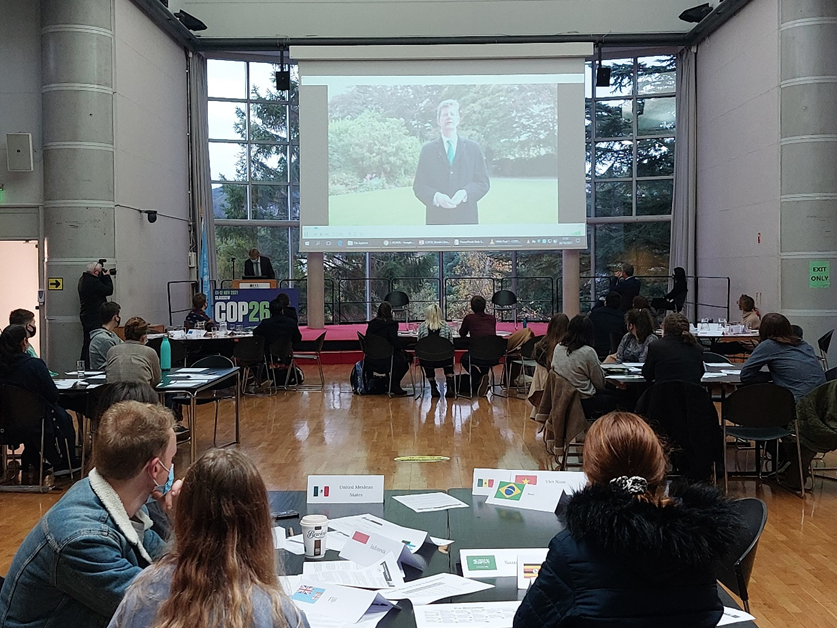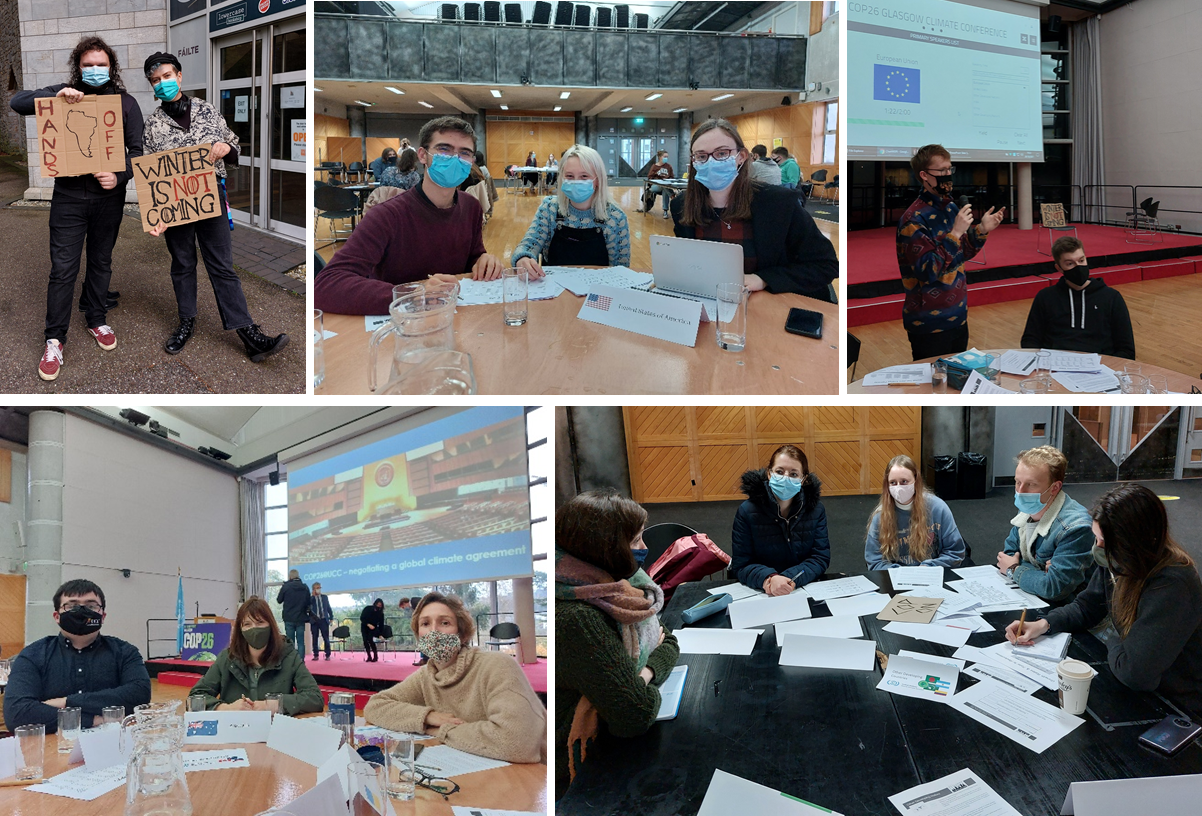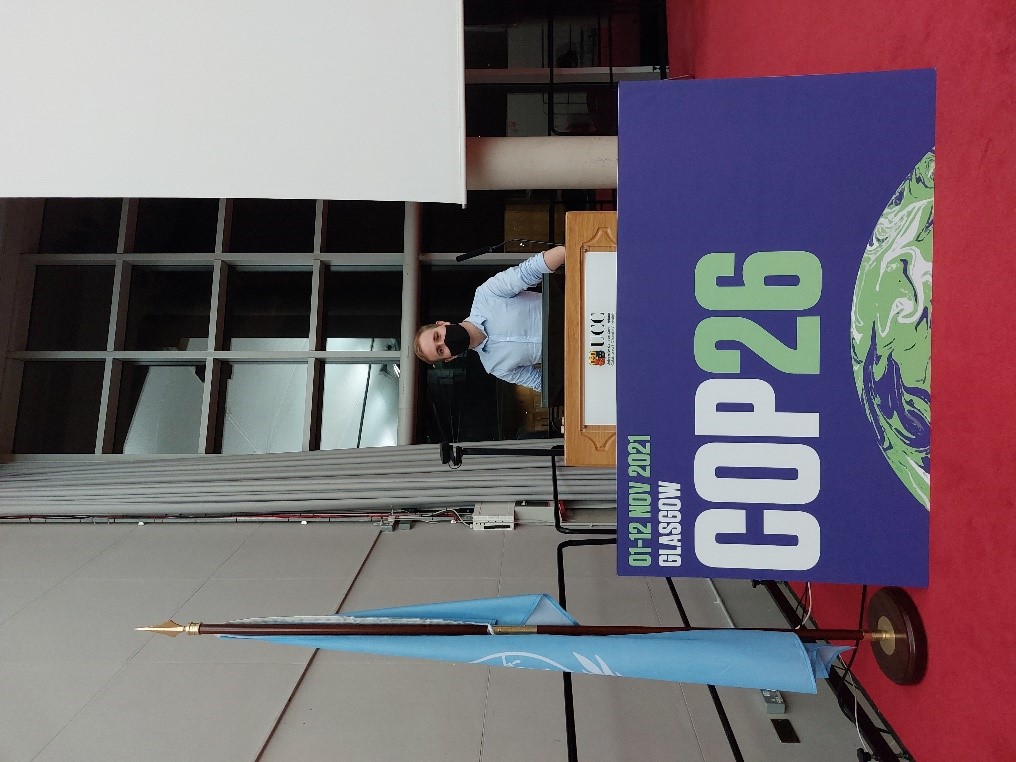- Home
- About
- Student Led
- Research Informed
- Practice Focused
- Resources
- News
- Green Campus Podcasts
- Case Studies
- Green Labs Community
News
Model COP26 at UCC

This week and next (Oct 31 – Nov 12) 196 nations of the UN have converged on Glasgow for the COP26 summit. UCC organised a number of outreach and engagement events to mark the occasion. The first of these was a Model COP26 which was held on October 26th in the Devere Hall.
The ‘Conference of the Parties’ brings nations together to accelerate action towards the goals of the Paris Agreement (COP21, 2015) and the UN Framework Convention on Climate Change (UNFCCC), to limit the levels of global warming and climate change. At COP26 each country’s individual climate obligations, known as Nationally Determined Contributions (NDCs) are due. The NDCs that have been committed to date are not enough to meet the critical targets required to limit global warming to 1.5˚C above pre-industrial levels. The signatories of the Paris Agreement are, however, expected to submit new, more ambitious, NDCs at COP26. The difference between 1.5oC and 2oC is substantial because every increment of a degree translates into increased risks for people, communities, and ecosystems, especially those of the island nations and the Global South. COP26 is thus a critical summit, representing the ‘last best chance’ for global climate action to halve global greenhouse gas emissions by 2030 and achieve ‘net-zero’ by 2050.
UCC as the only Irish University to hold official observer status at COP26 has sent a multidisciplinary delegation of academics, researchers and students to the conference. In addition UCC organised a number of outreach and engagement events to mark the occasion. The first of these was a Model COP26 which was held on October 26th in the Devere Hall. An initiative of the President’s Working Group on COP26 the Model COP26 event was organised jointly by the ERI, UCC Green Campus and a number of student societies including the Environmental, Law, International Development, International Relations, Engineers Without Borders, and Co-operative Societies. Each society contributed their various skillsets including experience of running large scale debating and Model UN events, and experience as environmental activist and advocates for sustainable development and social justice.
The Model COP26 welcomed undergraduate and postgraduate students of 15 different disciplines to simulate the UN summit. The event was opened by UCC President Prof. John O’Halloran who reaffirmed UCC’s commitment to taking meaningful climate action in line with national 2030 and 2050 targets. Prof. O’Halloran then introduced a video message from British Ambassador to Ireland, Paul Johnston, who outlined the COP26 ambitions to “keep 1.5o alive”.
British Ambassador to Ireland, Paul Johnston, addresses delegates at UCC Model COP26.

Students from diverse backgrounds ranging from Arts to Zoology were invited to represent various groupings of countries in the Global North & Global South. Delegates were tasked with negotiating a global pathway for climate action while other students assumed the role of disruptive environmental and social justice activists. Setting the scene, Prof. Áine Ryall challenged delegates to be alert to the inequalities between the Global North & Global South in the political and legal arena, and encouraged a human rights and climate justice approach to the evening’s negotiations. Energy and climate researcher, Dr Fionn Rogan, assumed the role of UNFCCC Secretary General, and framed the evenings events by outlining the current scientific trajectory and the urgency of action required to avoid global climate catastrophe. UCC’s delegation to COP26 and other experts from the ERI were on hand to act as scientific & political advisors to delegates.
In advance of the simulation, delegates were briefed on the position of the nation they were to represent, including national greenhouse gas (GHG) emissions per capita, the socio-economic status of that country and the public opinions of its citizens. The challenge was then for students to negotiate a pathway to limiting global warming to 1.5oC. After negotiating their position, delegates returned their pledges for annual reductions of GHGs, rates of afforestation and deforestation, and the proposed timeframes for such actions. Simulation software was used to model the pledges of delegates and determine the global temperature trajectory under that scenario.
Following public declaration of national pledges, the first round of simulation negotiations reached an agreement to reduce global GHGs to a level that would limit global temperature increases to 2.2oC. While this was an achievement of merit, the Secretary General was quick to remind delegates that such increases in global temperatures would still result in catastrophic climate events, impacting island nations and the Global South the most. The realisation that the developing nations were carrying a disproportionate share of the climate action burden despite having disproportionately low contributions to historic GHG emissions slowly began to ripple throughout the conference centre. This spurred much active debate and animated negotiations as delegates were determined to reach a better agreement.
Shane Goodman (UCC International Relations Society)
After the second round of negotiations, large emerging economies such as China and India pledged ambitious rates of GHG reduction on the condition that the USA, EU and other Developed Nations committed to do the same in proportion to their past contributions to the problem. Other developing nations also demanded that the Global North guarantee €100 Billion per annum to support the Global South in a just transition, ensuring that they can lift their citizens out of poverty, mitigate impending climate disasters and secure thriving low carbon economies. Questions also arose from the EU and other developed nations as to whether the USA’s emission reduction pledges were proportionate to the scale of their GHG contributions which are double that of EU per capita. Ultimately, the second round of negotiations saw pledges for greater and faster emission reductions from the USA and EU. This resulted in an agreement that would limit global warming to 2oC, much to the dismay of the island nations.
The event brought the relevance. The simulation highlighted to participants the difficulties in mapping a pathway to keeping 1.5oC ambitions alive, especially when delegates must represent national interests, above that of a global solidarity. In a debriefing session after the event students were struck by the reluctance of the Global North to take action proportionate to their historic contribution to the climate crisis, and the disproportionate burden of climate action on the Global South. Students expressed the opinion that the event opened their eyes to the complexity of the climate crisis. The students also observed that elected representatives must be accountable to their pledges at COP26 if we are to ensure a human rights and climate justice approach to this global crisis.
The UCC Green Campus programme is immensely proud of the contribution our students make to creating a culture of sustainability on campus and in the wider community. The Model COP26 event was extremely rewarding as an event because it allowed us to reach beyond our regular cohort of student activists to student groups and societies that are not normally engaged with sustainability activities on campus. A key outcome of the event was how well it illustrated that disciplines as diverse as the humanities, social sciences, law, economics, politics, science and engineering all have a role to play in finding transdisciplinary solutions to the climate crisis.
Student delegates during the Model COP26 Negotiations.


